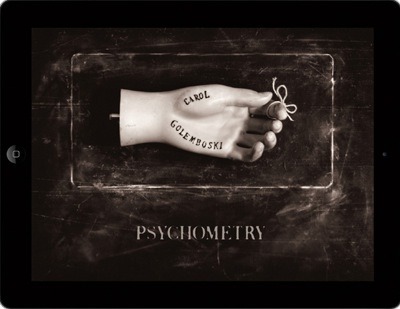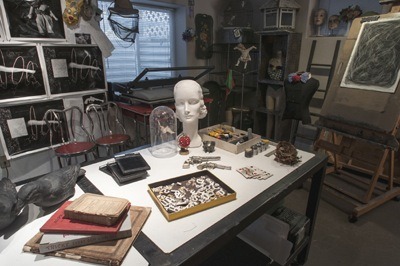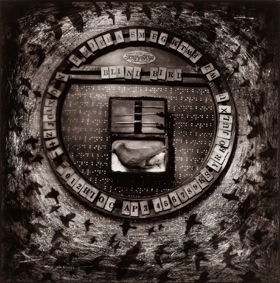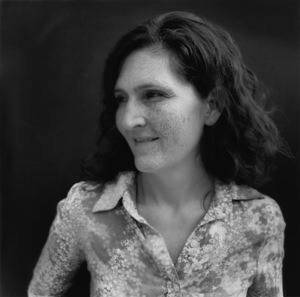Meet A NYFA Artist: Carol Golemboski
Carol Golemboski, self-portrait, 2012
NYFA speaks with Carol Golemboski (NYFA Fellow in Photography, 2002) about her new interactive artist’s book for the iPad, Psychometry, based on her photographic series of the same name. Psychometry recently won the “Outstanding E-Book Achievement” award from the Independent Publisher Book Awards.

Psychometry app cover, 2013
NYFA: Will you tell us about your Psychometry photo series?
CG: In the Psychometry series I photographed arrangements of old objects in dilapidated spaces as metaphors for human emotions and psychological states. The term “psychometry” refers to the pseudo-science of “object reading,” a purported psychic ability to divine the history of objects through physical contact. I wanted the objects in these pictures to seem haunted—to transcend their material nature and evoke the mysterious presence of past.
I created these images in the darkroom through extensive photographic manipulation. The negatives are often scratched, and the imagery is a combination of traditional photography and drawing. I love the fact that photography gives these pieces a basis in reality but the manipulations, which expand upon age-old darkroom “trickery,” allow me to create a space that resides somewhere between fact and fiction.

Planisphère Céleste, Toned silver gelatin print, 17.5" x 17.5", 2003
NYFA: I find it very interesting that you choose to explore what you have called “antiquated” imagery through both older processes, such as the darkroom, and new media. Where did the inspiration come from to create your interactive artist’s book?
CG: I was introduced to the idea of the iPad as a platform for an artist’s book by a former student. At first I was concerned that the technology might be at odds with the historical aspects of my photographs. As a darkroom photographer, I feared that that new media might not be the best way to present silver prints. What changed my mind was the realization that an interactive book could give behind the scenes information about my creative process. I designed it to enhance a viewer’s experience and appreciation of my work—to provide something that they might not get from a traditional book, or even an exhibition.
NYFA: Will you describe some of the key factors you considered when transmuting the photographic series Psychometry to its digital artist’s book form?
CG: I wanted this digital book to include the same elements that one might find in an artist’s monograph—a curator’s essay, a statement by the artist, and of course the images, about fifty in the series. However, I also thought I should take advantage of the unique interactive features of the platform by incorporating video, virtual tours, slide shows and hyperlinks. This allows viewers to interact with my work in ways that are only possible in this format. Traditional art books have a wonderful physicality and I don’t see apps and ebooks replacing them. I do think, however, that these new platforms have the potential to provide viewers with a completely different experience, and artists with a new avenue for exposure and self-publishing.
In terms of making a digital book of this specific series, I considered the things that people enjoy learning when I give lectures and workshops. This includes the stories behind the pictures, information about the objects or the locations, details about specific short stories or poems that inspired certain pieces, and the how-to of my darkroom manipulations. The pictures in Psychometry are designed to be mysterious, foreboding and ironic. I wanted the interactive book to have a little bit more whimsy and to be as much about the creative process as the images themselves.

Bending Spoons, Toned silver gelatin print, 17.5" x 17.5", 2003
NYFA: How do you feel that the incorporation of new media in your practice has impacted your creative process?
CG: Working with new media was completely unchartered territory for me. I had to step up my working knowledge of video and digital imaging and the learning curve was steep. To create the book/app, I hired a fantastic designer named Roxanne Davison at Brainchild Blueprints. Even though I had the final say on the finished product, the project was a great collaboration. I provided the imagery, the text, and the overall direction, and Roxanne came up with ideas for the design, both in terms of the layout and the interactive features. We reviewed the results together and determined if the various elements were reaching the aesthetic and functional goals we intended.
I love working in the darkroom, and I will probably continue working with film and traditional materials as long as they are available, but because of this project I’ve got one foot in each world at the moment.
NYFA: What is one of the greatest obstacles you as an artist have had to overcome?
CG: The most challenging thing I’ve faced as an artist is finding the energy to be creative while juggling my academic career and the responsibilities of family life. I’m a professor and I’m married with two young children. To avoid exposure to chemicals, I took a break from the darkroom during my pregnancies. Later, even though I had plenty of ideas, I didn’t have the stamina or mental space to follow through with labor-intensive creative projects. This was difficult to reconcile because I wanted to simultaneously be a great mother, a great teacher, and a great artist, but there just weren’t enough hours in the day. Now that my kids are a little older, I’m finding more time to perform this balancing act.

Carol Golemboski Studio, 2012
NYFA: Which aspects of your work do you find most fulfilling?
CG: I love those initial moments of inspiration. I enjoy hunting for props for my photographs at estate sales, flea markets and antique stores. The objects themselves often provide the trigger for a new photograph. I experience those same moments of excitement when I’m arranging objects in front of the camera and when I’m working in the darkroom. Because the negatives are just a starting point for me, I approach each picture like a visual puzzle that needs to be solved. I build it layer by layer until the image has the right level of mystery and conceptual intrigue.
Of course, it’s also great to feel that other people are responding to something I’ve created. There’s a certain satisfaction in knowing that I’m communicating my ideas and contributing to a dialog about the human experience, even if the images are designed to be open to interpretation.
NYFA: On the business end of things, what do you consider the most challenging aspect of managing your artistic career, and how have you dealt with it?
CG: As an artist, marketing and promotion can feel like a full-time job (and almost need to be treated as such). Early on I learned the value of taking advantage of every opportunity to get exposure for my work. I realized the importance of throwing my hat in the ring, even if I thought my chances were low. Sometimes I was surprised by the results.
In terms of the Psychometry app, promotion has presented all sorts of new marketing challenges. It can very easily get lost with all the other apps in the App Store. The concept of an interactive artist’s book/app is also new enough that most people don’t know exactly what it is. Because I’m primarily relying on word of mouth, I’ve found that social media has been a great tool to keep people apprised of the release, reviews and updates. I’ve also contacted a broad base of art and photography professionals who might help me promote it, including my galleries, The Robert Klein Gallery and Kevin Longino Fine Photographs, which are selling limited edition 8” x 10” prints to celebrate the release.
One of the good things about this format is that, unlike a traditionally printed monograph, which can cost on average $60.00-$100.00, my app only costs $9.99. I’m hoping that as more and more people purchase tablets, apps and ebooks might be more accessible than their traditional counterparts.
NYFA: Is the Psychometry app exclusive to iTunes or is there another way to purchase or download it?
CG: At this time, the app can only be viewed on an iPad or an iPad mini. It’s available for purchase and download through iTunes and the App Store for iPad.
NYFA: How did winning the NYFA Fellowship for Photography in 2002 affect your career?
CG: Winning a NYFA Fellowship was fantastic for my career in a variety of ways. In the most practical sense, fellowship money allowed me to purchase unusual props for that I would never have been able to afford otherwise. I also felt a greater freedom to experiment because the financial burden of buying photographic materials like paper and film—which can be quite expensive for a young artist—was lifted. The fellowship allowed me to take greater risks and push my work in ways that I hadn’t before.
The other thing that the NYFA Fellowship did was to lend credibility to my work. Being a NYFA Fellowship recipient opened doors for me in the gallery world, and also in the academic world, as I was applying for tenure track teaching positions around the same time period. I have worked with a variety of galleries since I received the fellowship, and I am now an Associate Professor and the Area Head of Photography at the University of Colorado Denver.
NYFA: What are you working on currently?
CG: Right now I am working on a series of photographs relating analog and darkroom photography to magic. The Psychometry photographs involved all sorts of darkroom tricks. I thought I’d extend the idea of photographic manipulation, illusion, and deception by borrowing clichéd imagery about magic. I also wanted there to be a bit of wonder in the pictures, where viewers know that they’ve been tricked but they appreciate the fact that they can’t quite figure out how it was done. This series references the environment of the darkroom as a magical place, where the physical and chemical nature of a print coming up in the developer feels like witnessing (or performing) a magic trick.

Blind Bird, Toned silver gelatin print, 17.5" x 17.5", 2005
—Interview by Lara Hidalgo
Psychometry is available for download from iTunes.
For more information on Carol Golemboski, please visit her website .



